Fitness app development requires an understanding of the target users, what they like and do not like in the app, what type of fitness app is most popular, and how many competitors’ fitness apps have a loyal user base. Such information holds the key to a strategy that helps understand how to create a fitness app that can succeed and survive in the market.
What makes fitness apps famous?
Providing virtual physical training, nutrition, and diet advice, and teaching other healthy activities like yoga and meditation has made fitness apps popular among every generation in the last few years.
The COVID pandemic had much to do with such fame since most people were looking for exercise routines and diet plans online. As a result, Global Fitness App Market size was valued at USD 1.5 billion in 2022 and is poised to grow from USD 1.7 Billion in 2023 to USD 6.5 Billion by 2031, growing at a CAGR of 17.7% in the forecast period (2024-2031).
Essentially, fitness apps are a type of healthcare application that motivate a healthy lifestyle, mental wellness, yoga, and workout/exercise. That is why you must understand every aspect of building a successful fitness app to learn how to make one for your business.
Top 2 Successful Fitness Apps to Know About
Knowing and learning qualities that can make a fitness app successful is the first step toward its success. And there is no better way to do that than by learning about and researching the top fitness apps, which will be your prominent competitors.
Only by knowing what your competitors are doing right and wrong can you develop a fitness app that can stand out.
FitOn
FitOn is one of the most popular fitness apps available in the market right now. It has 5+ million downloads on Google Play Store, with 4.5+ ratings on both Google Play and Apple App Store. This app gained popularity by including multiple celebrity trailers like Gabrielle Union, Cassey Ho, Kenta Seki, and Julianne Hough.
It has a free version with many workout programs and a pro/paid version with customized meal plans, 450+ recipes, virtual coaching, unlimited offline downloads, and fitness tracker integration. FitOn also includes coaching videos for strength training, HIIT, cardio, dance, yoga, pilates, and kickboxing.
Free access, high-quality videos, celebrity trainers, multi-platform app compatibility, and offline downloads are some benefits of the FitOn app.
The cons are disorganized fitness video libraries, lack of customization in mobile apps, and no features for fitness level indication, which can create a bad user experience for some users, yet the app is satisfactory for most.
MyPlate Calorie Counter
MyPlate Calorie Counter allows users to track their calorie intake and manage it. The app has 1+ million downloads and 4+ ratings on Google Play Store, with 4.5+ ratings on the Apple app store.
It includes a Database of 2 million food items, a Barcode Scanner for food searching and tracking, Customizable food and meals, Personalized daily calorie goals, Data regarding calorie intake, water intake tracking, 24/7 community support, meal-time Reminders, Google Fit app Integration, Customizable exercises, and Progress Tracking feature.
The MyPlate Calorie Counter also provides a choice between free and premium accounts. They both offer different benefits to users.
You can take inspiration from fitness apps like these to understand what you can do better to create a user-driven fitness application.
Types of Fitness Apps
You must analyze the potential of every type of fitness app to determine which is more feasible and beneficial for your business.
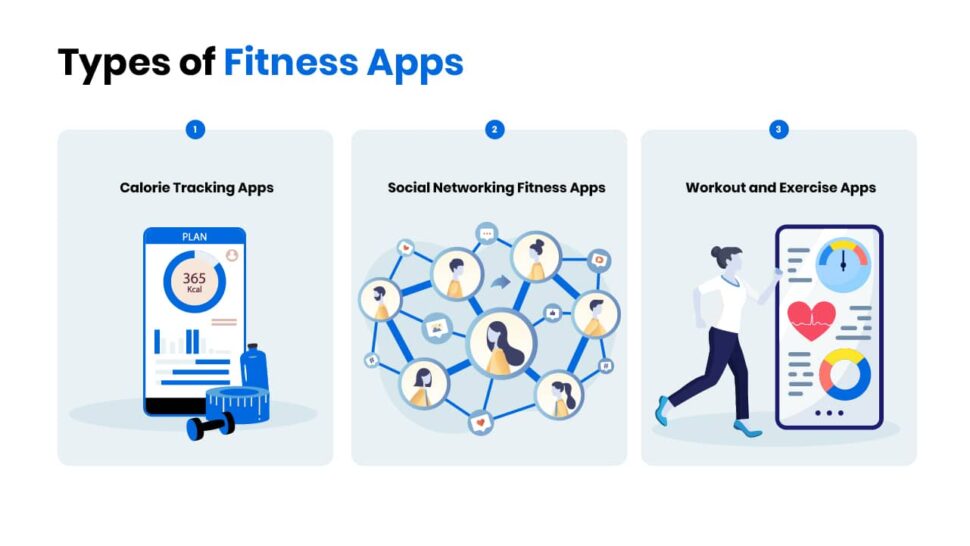
Calorie Tracking Apps
Diet and nutrition or calorie tracking apps allow users to plan, manage, and track their fitness and calorie intake goals. These apps can include calorie intake meal plans, fitness regimes for managing calories, real-time calorie tracking, and data that gives a detailed report on calorie intake, fitness improvement, and overall progress. Calorie-tracking and nutrition app development is currently one of the most popular projects in the fitness industry.
Social Networking Fitness Apps
Social networking fitness apps allow users to share their progress on the platform and follow fitness trends. This app can motivate users to follow a fitness regime and diet plan with more dedication since they do it as a group. These apps can also include live videos, fitness training, and fitness challenges created by many users. It is an ideal application for users that cannot continuously stay motivated toward fitness and diet goals.
Workout and Exercise Apps
Workout and exercise apps focus on workout regimes, whether they are for losing weight, strength training, muscle growth, or cardio. These apps include many free and paid trainers, while some provide an all-in-one workout regime course.
Yoga apps are also popular exercise platforms that provide virtual instructions and access to teachers for learning many yoga asanas.
How to Generate Revenue with a Fitness App?
Knowing how to generate revenue from your fitness app is something you must plan before the development process begins. It will allow you to incorporate various revenue streams into your fitness app.
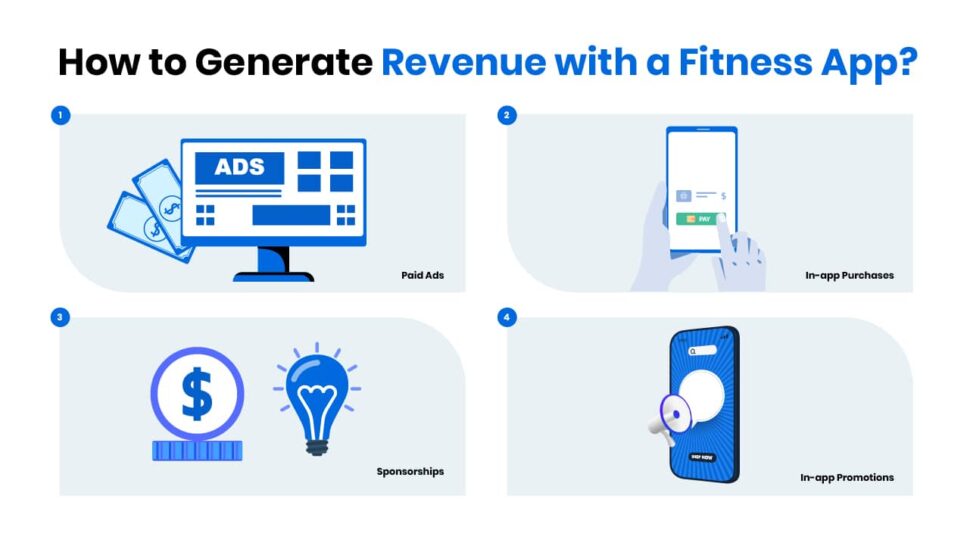
Paid Ads
Including personalized advertisements in your fitness app is a great way to begin generating revenue after deployment. You must ensure the ads are relevant to your users and offer some rewards for watching video ads (like one-time access to a premium feature).
In-app Purchases
In-app purchases in a fitness app would include a premium account subscription and fitness products like yoga mats, private training services, exercise courses, diet and nutrition courses, muscle training weights, and heart-rate monitors.
Sponsorships
Partnering with fitness influencers and professional trainers can help you improve your user base and generate revenue at the same time. You can include and promote their content on your app along with links to their websites.
In-app Promotions
In-app promotion is about advertising the trainers, teachers, and their courses on your application. Since your fitness app will have many trainers/teachers, exercise courses, and diet and nutrition plans by nutritionists, many of them will want to increase the discoverability of their offerings on your app. You can make that easy for them by advertising their profiles/content for a predetermined weekly/monthly fee.
How to Build a Fitness App in 10 Steps?
Following a well-planned and strategic development process is the only way you can build a fitness app that can outperform the competition.
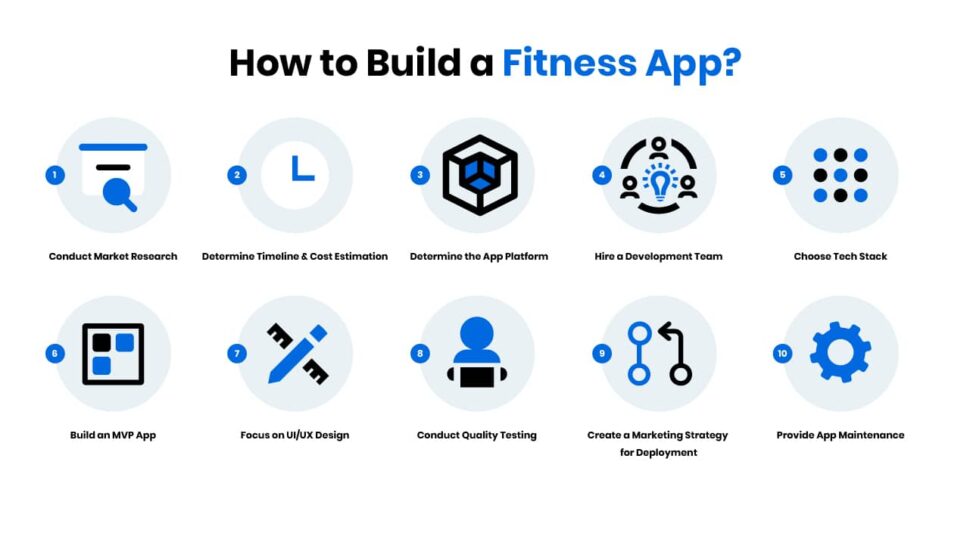
Conduct Market Research
The market research for mobile fitness apps includes surveys with target users, competitor app evaluations, research on current and new development technology, and product discovery. These steps help you gather valuable information to conduct better project planning and execution.
In market research, Product Discovery is a necessary step where you discuss the idea and potential of your fitness app. You discuss questions like:
- What is the target user base for your fitness app?
- What are your business goals?
- What do users expect from a fitness app?
- What issues do they have with fitness apps?
- How many competitor apps are there?
- How many competitor apps have a loyal user base?
These questions allow you to identify target user needs and the strengths/weaknesses of competitors. This, in turn, helps you create a user-driven development plan for an application that can provide much better services and products than competitors.
Determine Timeline and Cost Estimation
While the project timeline and development costs depend on business goals, fitness app developers, and application complexity, the average cost to build a fitness application ranges from $8,000 to $35,000. The rates for your fitness app will depend on the factors mentioned above since every project has different requirements.
Similarly, the duration for building a fitness app can range from 200 to 500 hours based on app complexity, platforms, technology, developers, and development strategy.
| Fitness App Development Costs and Timeline Based on Complexity | ||
| Complexity | Cost | Hours |
| Simple/MVP App | $8,000 to $12,000 | 200 to 250 hours |
| Standard App | $18,000 to $35,000 | 300 to 450 hours |
| Complex Fitness App | $45,000 to $80,000 | 500 to 650 hours |
Determine the App Platform
Choosing an app deployment platform is necessary for the app development process. You must determine where you are building a single-platform or cross-platform app.
A single-platform app would be available for a specific user base like Android or iOS users. And a cross-platform app would be available for multiple platforms like iOS, Android, Windows, and macOS. Cross-platform development is also cost-effective and faster.
But if you aim for a high-performance fitness app, you can choose to build a Native fitness app for every platform. The development costs will be higher than cross-platform, but you will have a high-performance application with an advanced interface, improving the overall user experience of your fitness app.
In short, you have three options-
Build a native application for one single platform like Android or iOS, faster and cost-effective but limits the reach of your app.
Create a separate native app for multiple platforms like iOS, Android, and macOS. The process is costly and time-consuming but delivers a user-friendly and high-performance application that can stand out in the fitness app market.
Build a cross-platform app for multiple platforms like iOS, Android, Web, Windows, and macOS using a single reusable codebase. It is a cost-effective process that simplifies and accelerates development while delivering a user-friendly application (if you hire a capable development team).
Hire a Development Team
Hiring the right development team for a fitness app can be tricky as you have multiple options in the app development market. You can create an in-house team, hire freelance developers, or outsource to an onshore, nearshore, or offshore fitness app development company.
Creating an in-house team will require you to provide a workspace, utilities, resources like internet, computers, and laptops, and an employment package for every member like business analyst, iOS developer, Android developer, backend developer, QA engineer, Tester, UI/UX designer. However, planning and managing your health and fitness app development project will be much easier.
Hiring freelancers will be easy and cost-effective but unsafe if you have a unique idea. Freelancers are not easy to monitor or manage, and sharing common or sensitive data related to your fitness app or organization can be risky, leading to data theft or leaks. With an effective hiring process and monitoring, you may be able to find the right freelance developers and manage them, but it is best to avoid this option.
Outsourcing to onshore and nearshore developers is not different from an in-house development team since costs for both are nearly similar. However, they are easy to find and monitor and take responsibility for team management and collaboration.
Outsourcing to offshore developers is by far the most lucrative option when hiring developers. Offshore developers are cost-effective, self-sufficient, and understand the global app market well. They rarely need monitoring since they have an effective system for timely deliveries, quality-driven development, and team collaboration.
Choose Tech Stack
Which technology stack you choose for your fitness will determine the functionality/performance, development cost, and project timelines. Therefore, it is best to choose them with the assistance of an experienced app development team. They have a better understanding of the tech requirements of various applications.
Below you can go through the list of tech stacks for your fitness app, most of which will be essential for your development project.
| Tech Stack for a Fitness App | |
| HTML 5 | Google Maps Android IP |
| CSS3 | MapKit |
| JavaScript | Google Directions API |
| Angular js | Google Places API |
| Swift | Twilio Communications |
| Vue.js | Google Cloud Messaging |
| Ruby (Ruby on Rails framework) | Apple Push |
| Kotlin | Stripe |
| Python | PayPal’s SDK |
| PHP | Apple Pay |
| Google Location API | Core Location |
Your fitness app development project will need less or more tech stack than mentioned above, based on project goals, app complexity, security requirements, and developers.
Build an MVP App
It is best to start with a minimum viable product if you are building a fitness app for the first time. An MVP app is a simple version of your application with only the core features required to meet the needs of target users.
Creating an MVP app is cost-effective and faster, allowing you to test it quickly and prepare for deployment in no time. You can monitor the user feedback after deployment and use it to turn the app into an advanced one with a user-driven approach.
Focus on Core App Features
Focusing on the core features is the best way to approach fitness app development, especially if you are building it for the first time. It allows you to better monitor the potential, strengths, and weaknesses of your business idea, project, and outcome without spending too much money.
Some core fitness app features are:
- Registration & Sign In
- User Profile
- Workout Menu
- Dashboard
- Diet Plans
- Push Notifications
- Social Sharing
- Geolocation
- Goals and Tracker
- Virtual Coaches
Incorporating such features in your fitness app helps you include all essential elements while accelerating the development timeline at affordable costs.
Focus on UI/UX Design
The user interface determines how your app looks and how easy it is to use the features and functionalities of your app. For example, you have a poorly designed user interface if it takes users more than 1 to 2 minutes to find a workout regimes section on your workout and exercise app. You also need to experiment with color psychology to create a workout app with color combinations, animations, and images that will appeal to your target users the most.
Unlike UI, user experience is about the experience users have with your whole application. It is about page loading time, quick or slow payments, and fast or slow search and buying experience.
A bad user experience usually leads users toward competitors, while a good one leads to increased user acquisition, retention, and customer loyalty.
Conduct Quality Assurance/Testing
App testing is necessary to identify and deal with functionality errors, bugs, and UI/UX design issues in your fitness app. Without proper testing, your app can have crashes, bugs, and unexpected downtimes, leading to a bad user experience; which is the primary cause of customer defections and app installations.
Therefore, you must conduct both manual testing (including UAT- user acceptance testing) and test automation (including pen testing) to ensure your fitness app meets all the necessary standards. Methods like user acceptance testing allow you to evaluate the fitness app from the perspective of end users.
It allows you to understand the user interface and experience from the point of view of your target users, providing valuable insights into what your app does well and lacks. You can use this information to improve the app, deal with bugs/errors, and apply the user feedback-driven approach to make the app more user-friendly before deployment.
Marketing Strategy for Deployment
Many target users can miss the release of your fitness app if you do not use an effective marketing strategy before deployment. Awareness and discoverability are the key elements that will determine the success of your app after release. Therefore, you must use an effective marketing strategy to spread awareness and increase application discoverability before you deploy it.
You can use methods like social media platforms (like Facebook, Youtube, and Instagram for advertising), email marketing, landing pages, influencer marketing, app store optimization (ASO), and content marketing.
Once you have spread enough awareness about your to-be-deployed app, you can increase its discoverability and user acquisition after deployment.
Provide App Maintenance
Every app requires maintenance for errors, UI/UX design issues, bug fixes, security issues, updates, and OS optimizations. As mentioned above, a lack of app maintenance can lead to a bad user experience, which leads to customer defections and app installations. Therefore, you must plan regular maintenance for the fitness app before you deploy it.
You can also monitor user reviews and feedback to provide user-driven updates regularly. It will help you increase user acquisition and retention rates for your app. More importantly, timely app maintenance creates a convenient user experience by dealing with or preventing app crashes, glitches, and downtimes.
Conclusion
Analyzing your business requirements and market expectations can help you build a fitness app that can succeed and survive its competitors. You can create a value-driven app for target users by addressing the need for user-friendly fitness apps. All you need is a one-stop solution app development company to plan and conduct the development process effectively.
Whether your niche is yoga, muscle training, or diet and nutrition, an all-in-one development team can strategically plan and manage your fitness app development project. They know how to build an app that can capture the attention of target users.
You can request an estimate for your app now and have the project started right away.
Frequently Asked Questions
The cost to build a fitness app can range from $8,000 to $80,000 and more depending on app complexity, UI/UX design, developers, and business goals.
It can take 400 to 1800 hours to build a fitness app depending on your developers, UI/UX design requirements, and development strategy.
A user-friendly interface, high performance with no interruptions, and value-driven products/services can make fitness or any app successful.
AI-based visual tracking for workouts and exercises could be the one thing lacking in fitness apps. It would effectively track the mistakes in the form of the workout/yoga, count the number of sets, and keep accurate records, which can better motivate target users toward their fitness goals.
Research the market, understand the target customers, estimate the project timeline and cost, hire a development company, focus on the user interface, build an MVP, conduct marketing before deployment, and provide app maintenance.
To ensure your fitness app generates revenue, you must thoroughly research the target customers and competitors before building an app. It will allow you to understand the demand for products and services in the fitness industry, the qualities that make competitors successful, and the qualities that they lack. You can then create a strategic development plan designed to deliver a value and quality-driven app that will provide a satisfactory user experience for all target customers.



















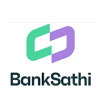

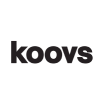
.png)
.png)
.png)



Leave a Comment